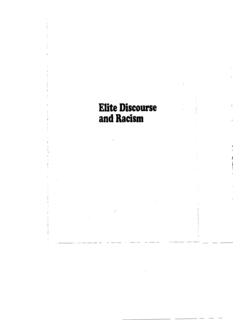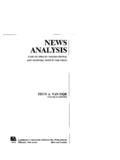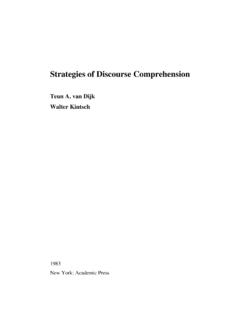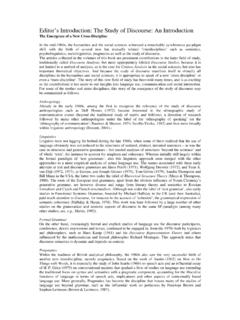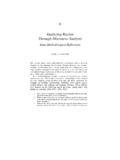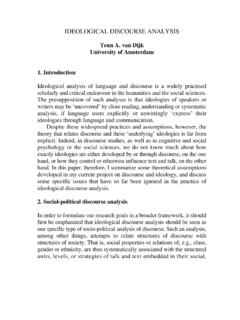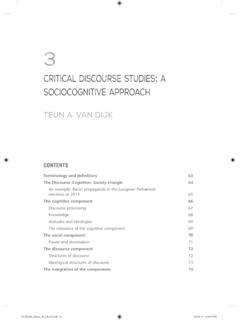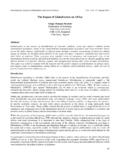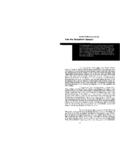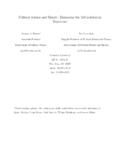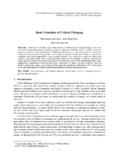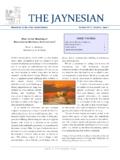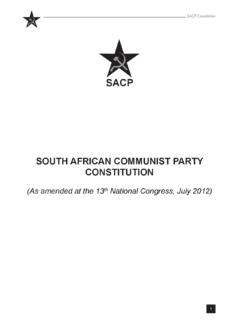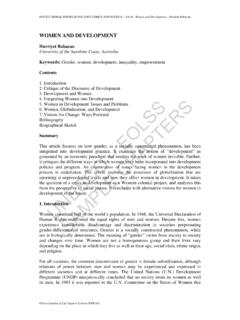Transcription of Ideologies, Racism, Discourse- Debates on …
1 5 ideologies , racism , discourse : Debates on Immigration and Ethnic Issues TEUN A. VAN DIJK Aims This paper studies some of the ideological properties of political discourse on immigration and minorities in contemporary Europe. It combines results of my current work on the theory of ideology (Van Dijk, 1998a) with those of an earlier large project on the discursive reproduction of racism (Van Dijk, 1984, 1987, 1991, 1993a).
2 More specifically, the framework of this discussion is an international project, directed by Ruth Wodak1 and myself, which examines and compares the way leading politicians in seven EU countries speak and write about immigration and ethnic issues. Although there are obvious contextual differences between immigration, race relations, and hence between talk about these issues in the various countries, the overall theoretical framework for their analysis is essentially the same.
3 This framework, which will only be briefly summarised here, combines elements from the following multidisciplinary triangle: (a) an elite theory of racism as a form of ethnic dominance and inequality, (b) a socio-cognitive approach to (racist, nationalist) ideologies and other social representations, and (c) a complex multi-level analysis of text and talk in context, in general, and of parliamentary Debates , in particular.
4 Thus, although file examples analysed in this paper are taken from a debate in the British House of Commons oil asylum seekers, it is assumed that many of the properties of this debate may also be found in immigration Debates in other western European countries. Earlier analyses and comparisons of Debates on immigration and ethnic issues in Western Europe shows that there are differences of style ( , in the UK, France and Germany, MPs may interrupt, heckle and shout, which is much less the case in Spain and the Netherlands), and of nationalist rhetoric (especially in France)
5 , but that the main topics, argumentation strategies and especially the standard arguments (topoi) against immigration are very much comparable (Van Dijk, 1993a). Comparative Perspectivas on racism 92 Another difference exists between countries where immigration has been taking place for some decades now (the UK, France, the Netherlands), and the countries where immigration is a more recent phenomenon (Italy, and especially Spain). In the first group of countries, issues of affirmative action, integration, minority policy, and other topics related to multicultural societies are more prominent.
6 In the latter countries, the main topic and concern of talk is still often that of new Immigration and their reception and integration. In the countries where large-scale immigration goes back several decades, there are also MPs who belong to immigrant communities (see also Hargreaves and Leaman, 1995). Common to nearly all cuuntrics is the current preoccupation with a flood of asylum seekers, a topic common to many Debates in most western European countries.
7 discourse and racism The issue to be theoretically dealt with here is the relations between ideology, racism and discourse . My first thesis about these relations is that both racism and ideology are prominently reproduced by social practices and especially by discourse . I am interested in these processes of societal reproduction and how exactly text and talk are involved in such processes. More specifically, from a more critical perspective, I want to know how discourse reproduces systems of dominance and social inequality, such as racism .
8 That is, the broader framework of my investigation is the type of analytical discourse research now commonly designated as critical discourse analysis or CDA (Fairclough, 1995; Fairclough and Wodak, 1997: Van Dijk, 1993b). This way of framing my problem entails that I do not equate racism with ideology, as is often done in the literature (Miles, 1989). racism does have an ideological basis, but cannot be reduced to it alone.
9 As a form of dominance and social inequality, racism also needs to be defined in terms of various types of social practice, such as discriminatory discourses and other acts of interaction, at the micro-level. At the same time it requires analysis at the macro-level, through analysis of institutional arrangements, organisational structure, and group relations of power abuse (for details. see the vast literature on the social and institutional dimensions of racism , , Essed, 1991; Feagin and Sikes, 1994: Marable, 1995; Omi and Winant, 1994; Solomos and Wrench, 1993: Van Dijk, 1991, 1993a; Wellman, 1993).
10 Although I do analyse ideologies in terms of the social cognitions of social groups, other social representations are also involved in this cognitive domain of analysis, such as knowledge, opinions or attitudes (such as preju-d i c e s ) ( D o v i d i o a n d G a e r t n e r , 1 9 8 6 ; F i s k e a n d T a y l o r , 1 9 9 1 ; F a r r a n d Comparative Perspectivas on racism 93 Moscovici, 1984: Spears, Oakes, Ellemers and Haslam, 1997).
